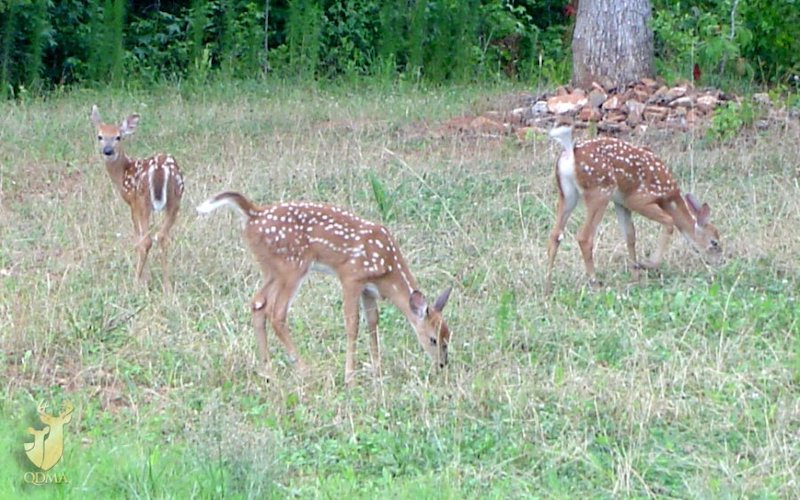Next time you need a babysitter, consider a cow elk. OK, elk can’t care for our babies, but they very much care for each other’s calves. Shortly after giving birth, cows and their calves form herds consisting of yearlings, older females without calves, and other cows with young calves. The herd helps protect calves from bears, wolves and mountain lions, while also giving new moms a break. In “nursery herds,” cows take turns watching the calves, which lets cows feed alone while taking time away from calf duty.

It’s possible for deer triplets to have three different fathers. Photo Credit: QDMA
When it comes to white-tailed deer and their fawns, paternity gets complicated. Twin fawns are standard in whitetails, and it’s common to see a pair of spotted fawns with one doe. But that pair might be half-siblings. According to the Quality Deer Management Association, about 25% of twin fawns are sired by different fathers. In fact, some triplets are sired by three different bucks!
Pronghorn are icons of the American West, but their closest relatives live in Africa. Many people think pronghorns, often called “antelope,” belong to the deer family. But deer, elk, moose and caribou are members of the Cervidaefamily. Pronghorns are the only surviving member of the Antilocapridae family, and their closest relatives are giraffes.
Moose are the largest member of the Cervidae family, and can measure nearly 7 feet tall. But their appetite is even more gigantic. According to the Minnesota Department of Natural Resources, a moose’s stomach can hold 100 pounds of food.
It’s wise to carry bear spray and/or bells when recreating in bear country. But long before bears can see or hear you, they can smell you if they’re downwind. Black bears have the best sense of smell in the animal kingdom. At a minimum, they can smell 100 times better than a human and seven times better than a bloodhound. In the right conditions, black bears can smell a meal at least a mile away. All the more reason to use bear-proof coolers to protect your lunch.
Just when you thought turkey hunting couldn’t get more challenging, add color to the list of potential reasons they’ll often bust you. Unlike deer, which have limited color vision, wild turkeys see a spectrum of colors and ultraviolet light. Therefore, the next time you throw your camo into the washing machine, wash them in detergents that don’t contain phosphates or chemicals that whiten and brighten clothes. Those soaps can brighten the clothing and make it more visible to turkeys.
The lack of daylight during winter gives some people the “winter blues,” making them sad and tired. For caribou roaming the Arctic, winter’s short days give them a different kind of blues: blue eyes. Caribou eyes take on a deep, rich blue in winter, but appear golden during summer. Researchers attribute the color change to the eyes adapting to extended periods of darkness.
Everything about a moose seems big, especially its nose. Their nose’s structure, however, serves a vital purpose. Aquatic plants provide much of the moose’s diet. Feeding under water is unpleasant for most animals, but moose have a special trick that lets them do so comfortably. Their nostrils close when exposed to water pressure, preventing water from entering while grabbing a bite.
Elk are atop many bowhunters’ bucket list. Besides obtaining hundreds of pounds of tasty meat, successful bowhunters also get a pair of ivories — the elk’s top two canine teeth, found in both cows and bulls. Elk ivories are authentic ivory. Scientists believe elk ivories are the remnants of tusks that ancient elk used in battle. Those tusks were replaced by antlers, but the ivories remain.